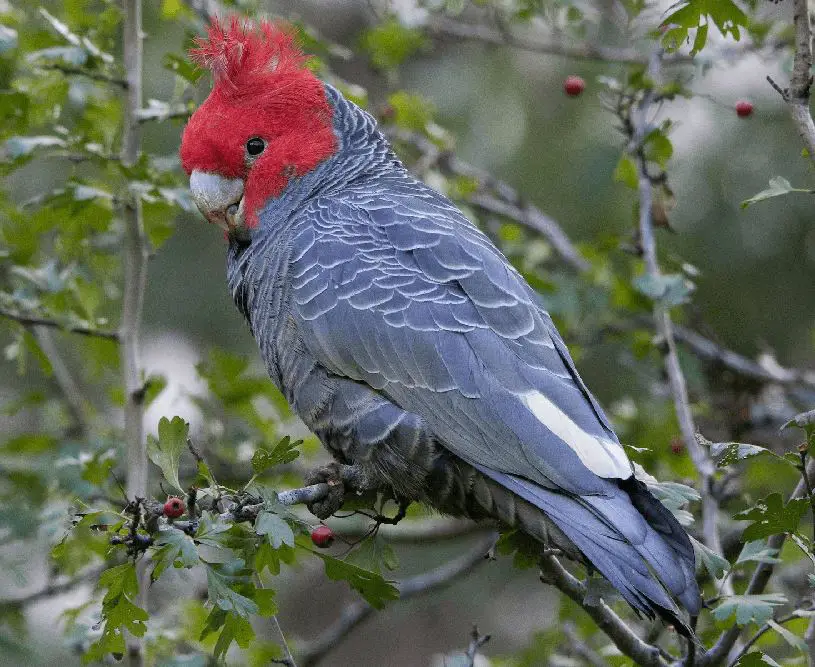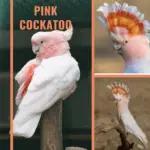
Gang-gang Cockatoo (Callocephalon fimbriatum), is a small member of the cockatoo parrot family with a stubby tail and long wings.
Fully grown gang-gang cockatoos are about 13-14 inches (32-37 cm) long, weigh about 8.4-11.5 ounces (240-330 g), and have a wingspan of about 24.4-30 inches (62-76 cm).
In appearance, the gangs are dark gray and have a distinctive wispy crest. The male’s crest is scarlet red and the female has both a gray crest and a gray body. Only two cockatoo species have redheads, the other being Major Mitchell’s cockatoo.
Male has general plumage grey, with head and crest orange-red; feathers of upperparts edged with white, and of underparts with yellow; wings and tail dark grey; eye brown, bill horn, and legs grey.
Females are generally similar, but head and crest grey, and much more prominently barred underparts are edged with orange and greenish-yellow; tail also barred.
Juvenile resembles adult female, but male shows some red on forehead, crown, and crest; juvenile female separated from a same-sex adult by the shorter crest, faint barring on tail and is generally darker and duller. Plumage maturation occupies c. 3 years.

Systematics History
Hybridization in the wild was recorded between females of the present species and males of Cacatua sanguinea. Monotypic.
Manningham’s Backyard Biodiversity: Gang-gang Cockatoo
SOURCE: ManninghamCouncil
Where do gang members live
the gang-gang cockatoo is restricted to Australia and Tasmania in the wild. However, it is not widely distributed in either location.
The gangs are only found along the inland and coastal regions of southeastern Australia and in northern Tasmania. Its name comes from an Aboriginal language spoken along the Australian coast.
The gang-gang cockatoo’s habitat varies with the season. In summer, these birds live at higher elevations and like to be in high forests and inland mountain woods.
When winter arrives, the gang-gang cockatoo may move to a lower elevation with a drier climate and less dense forests and forests. During the winter season, it is possible to see them in urban areas, usually in parks and gardens.
Altitudinal migrant, nesting high in mountain forests, but wintering (Apr-Sept)on the coastal plain and tablelands. In the past 50 years, species have taken to foraging in well-vegetated suburbs of towns and cities, particularly Canberra.
In some areas, Callocephalon is perhaps locally nomadic, e.g. in Snow Mts, SE New South Wales, where some are seen in the subalpine zone throughout the year. Rare vagrant to King I and N Tasmania.
Distribution
SE Australia from the Great Dividing Range to coast: from Hunter R, in N New South Wales (occasionally N to Dorrigo), S to extreme S of South Australia–Victoria border (mainly along with Glenelg R).
Gang-gang Cockatoo Diet

What do gangsters eat
cockatoos in gangs mainly prefer the seeds of trees such as forest acacias and eucalyptus. They supplement this mainstay of their diet by also eating insects, fruits, nuts, and berries when available. The gang-gang cockatoo spends most of its life in the trees and only when it needs to eat or drink does it go to the ground.
During the breeding season, gangs forage in small family groups or pairs. At other times of the year, however, they feed in flocks of up to 60 birds. A peculiar trait is that these birds invariably use their left foot to hold the food they eat.
Gang-gang Cockatoo Breeding
Gang gang cockatoo as pets:
Nests Oct–Jan. A nest is a hollow very high (c. 20 m)in a subalpine forest eucalypt, either dead or alive, but usually close to water.
Usually, two white eggs (1–3) are laid on a pile of decaying wood chips, created by the adults as they enlarge the tree hollow; the chick has sparse yellowish cream down;
in captivity, both parents incubate the eggs for 24–30 days and feed the nestlings for 7–8 weeks. Fledglings are fed for 4–6 weeks more; members of the family usually remain together all winter.
Gang gang Cockatoo Price
The price of a gang-gang cockatoo is between 1,000$ and 1,400$.
Conservation Status
Not globally threatened. CITES II. Generally common, and the population appears secure; indeed, appears to be becoming increasingly common due to overwintering in suburban Canberra.
At least in parts of Victoria, density estimates were highest in the forest that has been partially logged, but in S New South Wales numbers were greatest in continuous eucalypt forest. Nesting in tall forest trees that are difficult to find helps to protect present species from human nest robbers.
Gang – gang cockatoos : Australian birds
SOURCE: Rod Williams




















